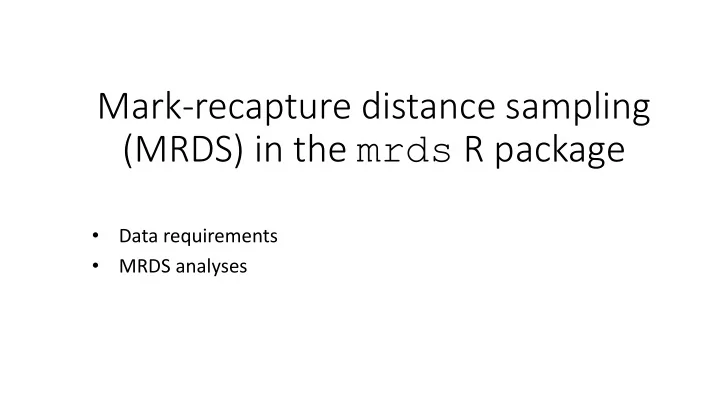

Mark-recapture distance sampling (MRDS) in the mrds R package • Data requirements • MRDS analyses
Data requirements Detection data must have: • 2 rows per object – one for Observer 1 and one for Observer 2 • Fields for: • object (unique object ID) • observer (1 or 2) • detected (1=yes, 0=no) • distance (perpendicular distance) • size (cluster size, if required) • Additional covariate data can be included • Tables for region and samples (see later)
Example: golf tee survey data – ‘detections’ Three required fields object observer detected distance size sex exposure 1 1 1 2.68 2 1 1 1 2 0 2.68 2 1 1 2 1 1 3.33 2 1 0 2 2 0 3.33 2 1 0 3 1 1 0.34 1 0 0 3 2 0 0.34 1 0 0
MRDS analysis library(mrds) E.g. Truncation Depends on method ddf(data, method, mrmodel, dsmodel, meta.data) Observer configuration and point/full independence ddf(data=detections, method=“trial”, E.g. mrmodel=~glm(link='logit',formula=~distance), dsmodel=~cds(key='hn'), meta.data=list(width=4))
When is DS model required? Observer Point/Full Method MR model DS model configuration independence trial Trial Point Yes Yes trial.fi Trial Full Yes No io IO Point Yes Yes io.fi IO Full Yes No
Additional covariates fit.mrds <- ddf(data=detections , method=“trial”, mrmodel=~glm(link='logit',formula=~distance+sex), dsmodel=~mcds(key='hn ‘, formula=~size), meta.data=list(width=4))
Results: goodness of fit tests, qq plots ddf.gof(fit.ddf)
Results: summary tables and plots plot(det.tables(fit.trial.pi)) det.tables(fit.trial.pi) Observer 1 detections Detected Missed Detected [0,0.4] 1 25 (0.4,0.8] 2 16 (0.8,1.2] 2 16 (1.2,1.6] 6 22 (1.6,2] 5 9 (2,2.4] 2 10 (2.4,2.8] 6 12 (2.8,3.2] 6 9 (3.2,3.6] 2 3 (3.6,4] 6 2
Results: detection function plots plot(fit.trial.pi)
Estimating abundance: dht dht(model, region.table, sample.table, obs.table) Region.Label Region.Label Sample.Label Area Effort Links detections to transects and regions Region.Label Sample.label object Note, can convert a flatfile format to hierarchical structure using Distance:::checkdata(flatfile)
Recommend
More recommend